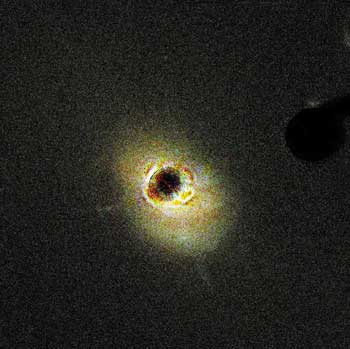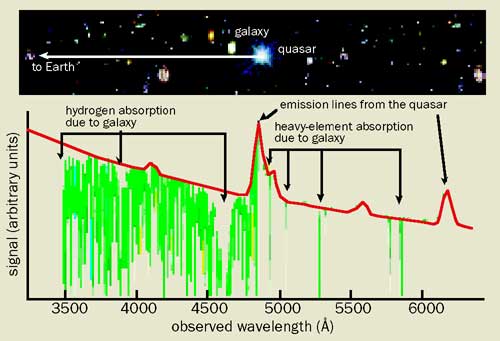Precise measurements on the light from distant quasars suggest that the value of the fine-structure constant may have changed over the history of the universe. If confirmed, the results will be of enormous significance for the foundations of physics

WHAT do we mean by “the laws of nature”? The phrase evokes a set of divine and unchanging rules that transcend the “here and now” to apply everywhere and at all times in the universe. The reality is not so grand. When we refer to the laws of nature, what we are really talking about is a particular set of ideas that are striking in their simplicity, that appear to be universal and have been verified by experiment. It is thus human beings who declare that a scientific theory is a law of nature and human beings are quite often wrong.
The development of a scientific theory has always followed the need to understand an observation for which no satisfactory explanation previously existed. When developing new theories, physicists tend to assume that fundamental quantities such as the strength of gravity, the speed of light in a vacuum or the charge on the electron are all constant. And when these theories are found to predict the results of new observations, our belief that these quantities are actually fundamental constants becomes even stronger.
Moreover, despite the rapid changes in technology in recent decades, the timescale on which fundamental new discoveries in physics are made is typically comparable to a human lifespan. This means that theories developed decades ago can appear as if they have been carved in granite.
The end result is a natural reluctance to change our understanding of the world. But it is vital to remember the limitations that have been involved in testing these assumptions. Many of the experiments we carry out to test theories are restricted to the here and now to Earth-bound research labs or to the small part of the universe that we can observe with telescopes. If we could somehow do our experiments in a different place or at a different time, we might well find that the results are different. Indeed, that is what appears to happen when we measure something called the fine-structure constant in the very distant past.
What is the fine-structure constant?
Have the laws of nature remained the same since the Big Bang some 13.5 billion years ago? Paul Dirac first posed this question in 1937, and he was still interested in this idea when he visited the University of New South Wales (UNSW) in Sydney in 1975 where I am now based. Dirac attempted to link the strength of gravity, which describes the large-scale properties of the universe, with the various constants and numbers that characterize the small-scale properties of the universe. In doing so, he claimed that one of the constants of nature, the strength of gravity, should change with time.
Although observations subsequently ruled out Dirac’s ideas, advances in many areas of physics and astronomy have resulted in a whole new set of opportunities for us to search for any hint that the constants of nature might vary. The particular question that I have been vigorously pursuing with colleagues at UNSW and elsewhere can be stated as follows: is the fine-structure constant really constant, or has its value changed over the history of the universe?
The fine-structure constant, α, is a measure of the strength of the electromagnetic interaction, and it quantifies the strength with which electrons bind within atoms and molecules. It is defined as α ≡ e2/h bar c ≈ 1/137, where e is the charge on the electron, h is Planck’s constant divided by 2π, and c is the speed of light in a vacuum. The fine-structure constant is of particular interest because it is a dimensionless number. This makes it even more fundamental than other constants such as the strength of gravity, the speed of light or the charge on the electron (see Constants with and without dimensions).
There are theoretical reasons why α and other dimensionless constants might vary with time. The holy grail of theoretical physics is to find a single unified theory that describes the four fundamental forces: gravity, electromagnetism, and the strong and weak nuclear forces. Although the strengths of these four forces differ, as do the distances over which they operate, most physicists believe that a unified theory will be discovered. If such a theory is not found, a great deal of the elegance and beauty of fundamental physics will be lost.
Einstein’s theory of gravity the general theory of relativity only requires three spatial dimensions. However, the leading contender for a unified theory requires extra dimensions beyond our familiar three. We do not know if these unified theories are correct, but if extra dimensions do exist, they must be tiny compared with our ordinary spatial dimensions.
The concept of attributing a “size” to a dimension may seem strange but it is important. The current size of the universe is determined by the distance that light has travelled since the Big Bang (i.e. about 13.5 billion light-years) and by the amount by which it has expanded since then. This means that the actual size of the universe is about 40 billion light-years and rising.
Are the extra dimensions predicted by unified theories also expanding at the same rate as the universe? The answer to this question is no. If the tiny extra dimensions were expanding at this rate, then the strength of gravity would also be changing very rapidly, and there is no evidence for this. However, it may be possible to infer the presence of these extra dimensions if they exist by detecting small changes in the strength of gravity or the other three forces.
It has been predicted, for instance, that “large” extra dimensions might cause small deviations in the inverse-square law of gravity over distances of less than 1 mm. However, recent measurements by John Price and co-workers at the University of Colorado at Boulder have failed to find any evidence for this over distances of about 100 µm (J C Long et al. 2003 Nature 421 922). This is just one of many experiments that have been set up to perform high-precision tests on constants, forces and fundamental symmetries in recent years.
There are several ways to measure possible changes in α with time. We can measure the absorption spectra of quasars at different redshifts, as we have done at UNSW. We can compare the “ticking rates” of atomic clocks made of different elements (see Searching for changes in the fine-structure constant using atomic clocks). We can also study the cosmic microwave background or the creation of the elements in the early universe. However, one of the first methods used to probe how α might have changed over the past two billion years relies on what must be one of the most unusual processes ever studied by physicists the so-called natural nuclear reactor at Oklo in Central Africa.




